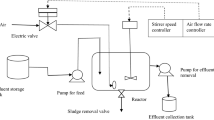This study was conducted to biologically treat wastewater discharged from the textile industry (textiles made of cotton and/or synthetic fiber) using sequencing batch reactor (SBR) technology (activated sludge process operating on batch mode). To achieve the objectives of the study, the characteristics of textile wastewater and the biodegradation of its organic constituents under unsteady state conditions were studied. Then, a bench-scale pilot plant was used to study the performance of SBR by monitoring the settleability and change in the constituents (chemical oxygen demand and solids) over time. Results of the study showed that textile wastewater has different types of pollutants: heat, basicity, suspended solids, organic and inorganic matter, and heavy metals. The factors affecting the biodegradation of organic matter were determined as the reaction time and the ratio of initial substrate to sludge concentrations. Also, removal of solids was monitored, and the settling velocity as affected by sludge concentration was graphically presented to enable the determination of settling time. Finally, the outcome of this study was used to suggest a procedure for the design of a full-scale SBR unit for treatment of textile wastewater.
Similar content being viewed by others
References
F. Roudi-Fahimi, L. Creel and R. De-Souza, Finding the balance: population and water scarcity in the Middle East and North Africa. Water-scarce countries in the Middle East and North Africa. Population Reference Bureau, 1875 Connecticut Ave., NW, Suite 520, Washington, DC 20009, USA, 2002.
S.H. Malkawi, Wastewater Management & Reuse in Jordan, Ministry of Water & Irrigation, Water Authority of Jordan Water Reuse & Environment Unit and First Regional Water Reuse Conference (7–9 Dec., 2003).
W. Eckenfelder, Industrial Water Pollution Control, 2nd edn. (McGraw-Hill, New York, USA, 1989).
Y. Al-Degs, M.A.M. Khraisheh, S.J. Alen and M.N. Ahmad, Effect of carbon surface chemistry on the removal of reactive dyes from textile effluent, Water Res. 31(3) (2000) 927–935.
R.L. Irvine, G. Miller and A.S. Bharmrah, Sequencing batch treatment of wastewater in rural areas, J. Water Pollut. Control Fed. 51(2) (1979) 244–254.
R.L. Irvine and A.W. Busch, Sequencing biological reactor an overview, J. Water Pollut. Control Fed. 51(2) (1979) 235–243.
P.A. Wilderer, R.L. Irvine and J. Doellerer, Sequencing Batch Reactor Technology. 1st International Specialized Conference on Sequencing Batch Reactor Technology, International Association on Water Quality, Munich, Germany, p. 9, 19.96.
L.H. Ketchum Jr, R.L. Irvine and P. Liao, First cost analysis of sequencing batch biological reactor, J. Water Pollut. Control Fed. 51(2) (1979) 288–297.
B. Helmreich, D. Schreff and P.A. Wilderer, Full scale experiences with small sequencing batch reactor plants in Bavaria, Water Sci. Technol. 41(1) (2000) 89–96.
W. Eckenfelder, Water Pollution Control, 1st edn. (Jenkins Publishing Company, New York, USA, 1970).
American Public Health Association (APHA), Standard Methods for the Examination of Water and Wastewater, 8th edn. (Washington, DC, 1992).
R.M. Sterritt and J.N. Lester, Microbiology for Environmental and Public Health Engineers, 1st edn. (E&FN Spon, UK, 1988).
W.V. Viessman and M.J. Hammer, Water Supply and Pollution Control, 4th edn. (Harper Collins, New York, USA, 1985).
R.E. Mckinney, Microbiology for Sanitary Engineers, 1st edn. (McGraw-Hill, New York, USA, 1962).
L.D. Benefield and C.W. Randall, Biological Process Design for Wastewater Treatment, 1st edn. (Prentice-Hall, Englewood Cliffs, NJ, USA, 1980).
Metcalf and Eddy, Wastewater Engineering, 3rd edn. (McGraw-Hill, New York, USA, 1991).
L.H. Ketchum, Design and physical features of sequencing batch reactors, Water Sci. Technol. 35(1) (1997) 11–18.
B. Teichgraber, Belebungsanlagen im aufstauprinzip-bemessung und anwendung, Korrwspondenz Abwasser 45 (1998) 886–900.
Author information
Authors and Affiliations
Corresponding author
Rights and permissions
About this article
Cite this article
Abu-Ghunmi, L.N., Jamrah, A.I. Biological treatment of textile wastewater using sequencing batch reactor technology. Environ Model Assess 11, 333–343 (2006). https://doi.org/10.1007/s10666-005-9025-3
Received:
Accepted:
Published:
Issue Date:
DOI: https://doi.org/10.1007/s10666-005-9025-3




